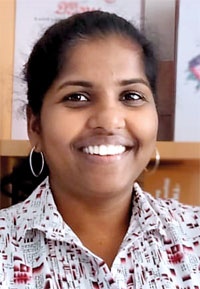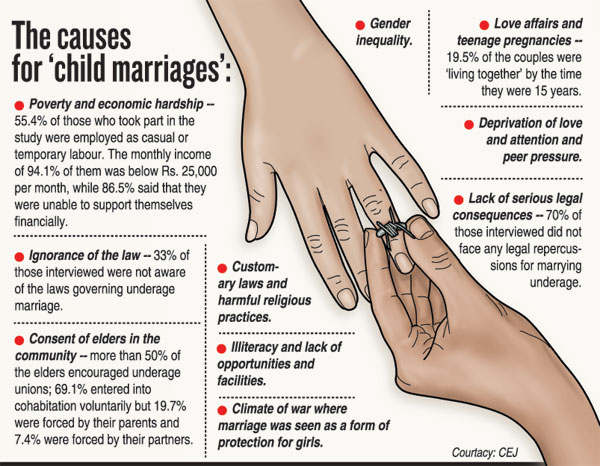News
Underage unions leave a trail of problems
They spoke not of love nor of tenderness – but of dire need due to poverty, lack of opportunities and much more and acceptance with stoic resignation.
They cohabited or lived together, had babies and even faced abandonment……..a majority were between 15-17 years of age, while some were even 13 and 14. This was below the lawful age of marriage which is 18 years in Sri Lanka.
Disturbing have been the findings of a study on ‘child marriages’ in three war-affected provinces in a country considered to be of ‘low prevalence’ with regard to this is

David McKinnon
sue.
“I eloped at 14 years to get away from family. My family didn’t encourage studies. We had to work or look after our siblings,” says one ‘victim’ from Ampara, while another from Trincomalee dwells on how her schooling ended in Grade 8, her father was ill, there were economic constraints and her mother went abroad to make ends meet. The family was in disarray and she was left with the huge responsibility of looking after her younger brothers and father.
“My life was aimless and full of frustration and hopelessness. ‘When will I get away from all of this,’ were my feelings from childhood,” she says.
For a parent in Polonnaruwa, when his daughter got involved with a boy from a rich family (owning a rice mill and a lorry), while schooling, it was the perfect match…..“The boy was going to inherit his ancestral home. I encouraged the relationship and invited the boy to live with us. My wife was only 15 when I married her. We are very happy together. Since it worked well for us, I thought it would work well for my children too.”

Shyamala Gomez
Another perspective is heard from Mullaitivu……“The gunshots, the noise and the smoke aside, we lived in fear of our lives. The neighbourhood was filled with houses of dead heroes and people grieving and crying. We used to hide in the bunkers and study and get scolded by the neighbours who questioned its purpose. But I still studied even inside the bunkers.”
These are the voices of the voiceless which were heard in Colombo on Friday, when the baseline study on ‘Lost Childhoods in War: Addressing early marriage as a human rights violation in war-affected districts of Sri Lanka’ conducted by the Centre for Equality and Justice (CEJ) and funded by the Canada Fund for Local Initiatives (CFLI) was presented to a diverse group at the BMICH.
The eight-month study had been carried out from May to December 2018 in the 10 war-affected districts of Jaffna, Kilinochchi, Mannar, Mullaitivu and Vavuniya in the Northern Province; Ampara, Batticaloa and Trincomalee in the Eastern Province; and Anuradhapura and Polonnaruwa in the North Central Province (NCP).
Canadian High Commissioner David McKinnon stressed the need for concrete action to prevent ‘child marriage’ and explained how such marriages hindered children from reaching their full potential. It was also a “complex” human rights issue, while impacting adversely on development.
Detailing the steps Canada has taken to safeguard “vulnerable” Canadians from such harmful experiences, Mr. McKinnon said that “together we can end child marriages”.
Earlier, in an exclusive interview with the Sunday Times on Wednesday, CEJ Executive Director Shyamala Gomez and Senior Programme Officer Letchumanan Kamaleswary stated how ‘child marriages’ had been brought to their notice by grassroots level organisations such as the Rajarata Praja Kendraya in 2014.
“They mentioned that young girls were getting into early cohabitation in the Sinhala border villages and that ‘child marriages’ were aplenty in the NCP,” said Ms. Gomez.

Shermila Antony Perera
Then came data collection from government servants and civil society for a rapid research. Finally, securing funding from the CFLI, the CEJ had sought the expertise of Prof. Subhangi Herath of the Department of Sociology, University of Colombo, to get the random sampling numbers, methodology and enumerator training right.
Ms. Kamaleswary said that, thereafter, the enumerators armed with 340 detailed questionnaires spread out across the 10 districts, conducting 60 in-depth interviews with victims of ‘child marriage’ and 20 face-to-face interviews with parents and guardians and 20 more with key informants. They had also held six public consultations with service providers including government and non-governmental stakeholders in Vavuniya, Trincomalee and Anuradhapura.
According to Ms. Gomez the term ‘child marriage’ describes a ‘marriage of a girl or boy before the age of 18 years. They include both formal marriages and informal unions in which children under 18 years age live with a partner as if they are married’.
“Child marriage is also often referred to as ‘early’ and/or ‘forced’ marriage,” points out Ms. Gomez, explaining that globally more than 12 million girls marry below the age of 18 every year.
Presenting the study on Friday, Visiting Lecturer of the Faculty of Law, University of Colombo, Shermila Antony Perera stressed how child marriages affect girls disproportionately than boys with the “prevalence among boys about one-fifth the level among girls globally”.

Letchumanan Kamaleswary
According to the UNICEF World Children’s Report 2017, children married below the age of 15 years in Sri Lanka are 2% and children married by 18 years are 12% between the periods 2010-2017, she said, adding that the minimum age of marriage for non-Muslims under the general law is 18 years for both boys and girls and the minimum age for statutory rape is 16 years. The relevant age when it is considered statutory rape for Muslims is 12 years and arguably the minimum age of marriage for Muslims too is 12 years.
“In Sri Lanka, customary marriage is also recognised as a lawful marriage. However, even customary marriages although lawful have to satisfy the essential requirements of a marriage such as capacity to marry,” said Ms. Perera.
Discussing the limitations of the study, she pointed out that Muslim marriages had been omitted; there had been time constraints; and some issues with the competence of enumerators and errors in documentation and translation.

| Girls were below 16 in over 50% of underage unions Here are some of the findings of the baseline study: Girls are more susceptible to marrying young — 21% of girls marry below the age of 15 years, while only 11.1 % of boys do the same.In the age-group 16-18 years, it was 78.4% of girls and 55.5% of boys who got into these marriages. As such, it is more common for the girl to be underage at the time of marriage than for the boy. A significant finding was that in more than 50% of these unions, the girl was below 16 years of age – which in legal terms amounts to statutory rape. Cohabitation was high (84.6%) within the 15-17 year age group. It was 6.8% in the 13-14 age group and 44.1% in the 15-16 age group. | |
| Poverty a major culprit The causes for child marriages according to the study were: · Poverty and economic hardship — 55.4% of those who took part in the study were employed as casual or temporary labour and 86.5% had said that they were unable to support themselves financially. The monthly income of 94.1% of them was below Rs. 25,000 per month and they were unable to meet the basic necessities such as food, housing and clothing. They were in debt and micro-finance companies provided loans without collateral at a price. From Ampara, came the pathetic tale of a 16-year-old forced, after constant beatings, by the parents to ‘marry’ a neighbour as they were indebted to him. Lack of educational opportunities & facilities – 70% had attended school up to Grade 11, but only 5.6% had completed secondary education. A majority of the girls marrying while being underage had mothers who had done the same. Lack of economic & social development Love affairs and teenage pregnancies – it was common to engage in sexual intercourse at an early stage in a relationship. 19.5% of the couples were ‘living together’ by the time they were 15 years and 70.2% by the age of 17. Ignorance of the law — 33% of those interviewed were not aware of the laws governing underage marriage. Even among those who knew the law, practice superseded theory, with more than 50% of elders encouraging underage unions. These had been exacerbated by the conditions of war, even so many years after the war had ended: Displacement Loss of life and property Security and safety concerns especially for girls The way forward in preventing underage unions Steps should be taken to fully implement the current laws on marriage and statutory rape. Public awareness campaigns on underage unions and their consequences, to create social change. Sexual and reproductive education to children through the school curriculum to prevent early sexual engagement, teenage pregnancies and cohabitation and ‘child marriage’. |

